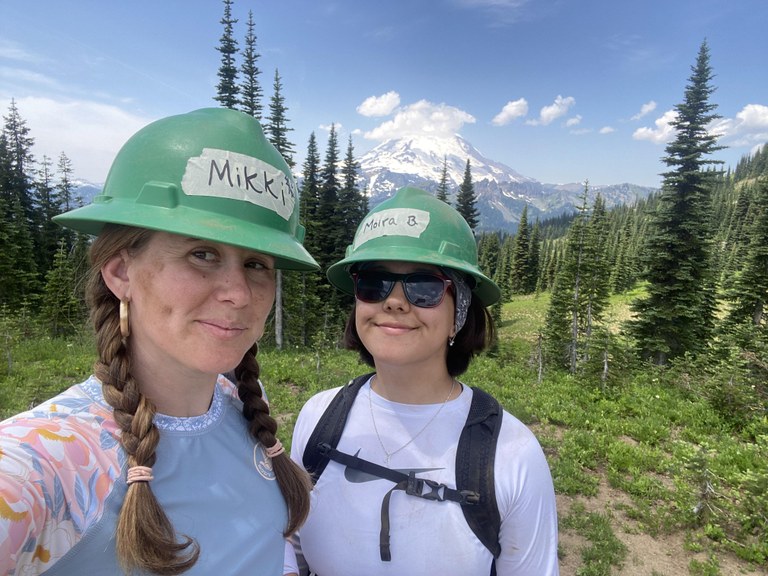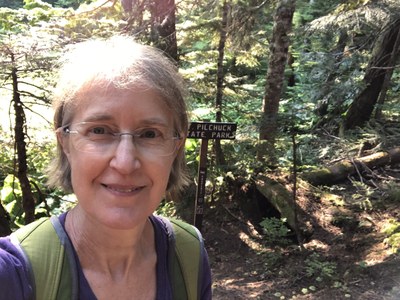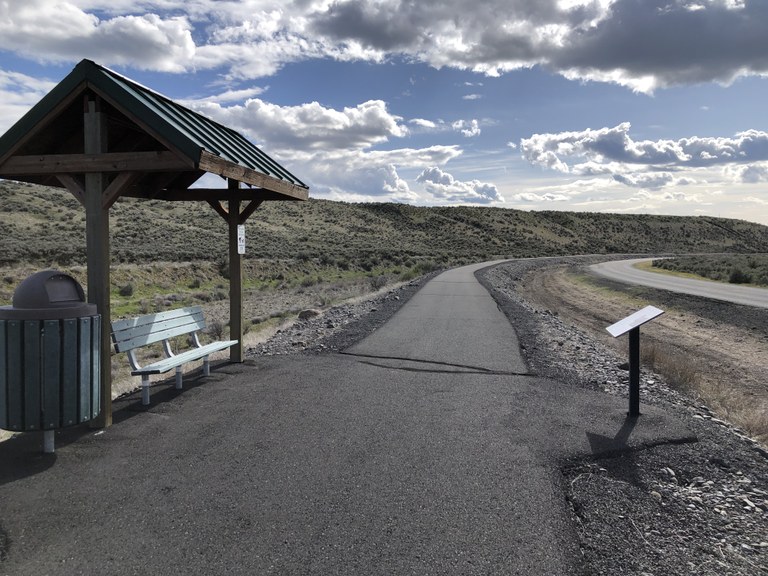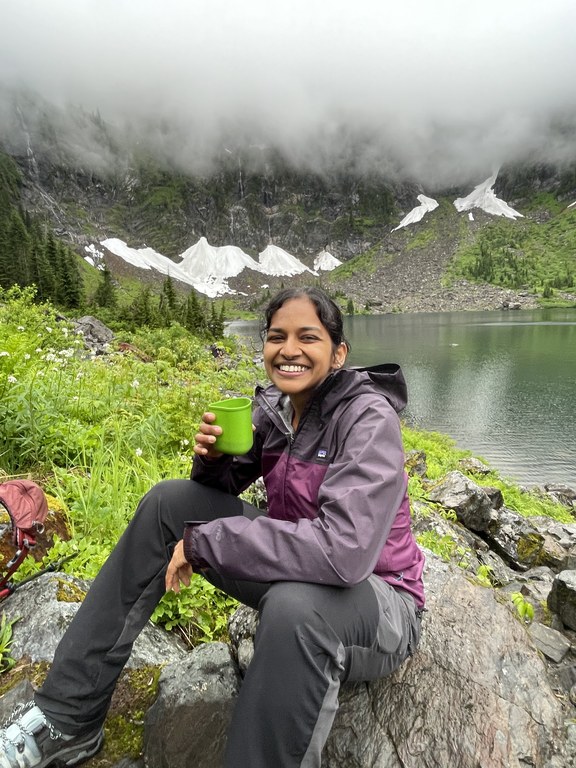 Washington Trails
Association
Washington Trails
Association
Trails for everyone, forever
Volunteers power WTA, and they do it all. Trail work. Hike research. Public education. Tool cache construction, trail advocacy, app development … the list goes on (and even includes unexpected things like pie delivery and 3-D printing). | By Anna Roth
Part of what’s incredible about our volunteers is their willingness to commit their time to WTA. Trail day work parties run 8 or more hours or can even be multiday excursions. Ambassador commitments can be half or full days. Researching and writing up hikes can take an entire weekend!
And yet each year, people dedicate thousands of hours to supporting our work. We’ve met parents and grandparents, students, people with full-time jobs and people who are brand-new to Washington in our volunteer communities. Trail maintenance volunteers on our summer backcountry trips drive hours from home to spend a week with strangers.

Volunteer ambassadors pose with a US Forest Service ranger at the Heather-Maple Pass trailhead in fall of 2024. Photo courtesy Jenn Seva
Ambassadors (pictured above) stand at trailheads instead of hiking so they can connect with hundreds of people. App development volunteers regularly work afternoons and evenings, sometimes even weekends. And our volunteers finish their volunteer days smiling, noting how friendly and welcoming the folks they meet are.
The longevity of volunteer commitments is incredible as well. It’s not uncommon to meet volunteers who have been with WTA for years. People go to school, get new jobs, have kids, retire and even move away, but they still give their time.
That generosity is central to WTA’s volunteer community. It extends to our members, whose financial contributions power all of WTA’s work, and it helps us achieve so much each year. There’s no way we can highlight every volunteer’s contribution; there are too many of you! But here are a few profiles that illustrate how people work WTA into their lives. We are endlessly grateful for these folks and every other person who contributes their time to us each year.
 Moira Boughton poses on the Naches Peak trail during a work party with Mikki. Photo by Mikki Boughton.
Moira Boughton poses on the Naches Peak trail during a work party with Mikki. Photo by Mikki Boughton.For Mikki and her daughter Moira, volunteering with WTA offers a chance to connect with each other and to explore Washington. The two also use volunteering as a way to explore the state.
“Our family spends as much time as we can outside, and now we can help make that space better,” Moira said. “It also is a thing that I get to do with my mom. I am a twin and have two other siblings, so getting one-on-one time with my mom is hard to do. Volunteering with WTA has given us a thing to do together.”
“I had the pleasure of working with Moira and Mikki for my first BIPOC [Black, Indigenous, and People of Color] work party on the Middle Fork Snoqualmie River trail,” said Angelic Friday, one of our crew leaders. “I was delighted to hear that they drove up from Yakima for it. Mikki said they don’t get a lot of opportunities to be in BIPOC-specific spaces and appreciated the thoughtfulness and space that (WTA staff) Moleek and I were able to make for everyone.”
Moira and Mikki’s first work party was closer to home, though, working on the Naches Loop Trail at Mount Rainier.

Mikki loved knowing they were making a difference on a trail that she and her family hike every year, and Moira enjoyed connecting with people from all walks of life, forming bonds with folks she would not have met outside of volunteering.
”Volunteering with WTA gives me a reason to get outdoors more, which is something I am always looking for. The joy of being outdoors is amplified by the fact that I get to do something that benefits others. Volunteering also means that I get to spend time with my family doing something bigger than us,” Mikki said.
 The first hike Mary Hartman wrote up was for one of her favorite local hikes, W.E. Johnson Park in Richland. WTA didn’t have an entry for it, so she just wrote it up and sent it in. She’d never written for WTA before.
The first hike Mary Hartman wrote up was for one of her favorite local hikes, W.E. Johnson Park in Richland. WTA didn’t have an entry for it, so she just wrote it up and sent it in. She’d never written for WTA before.
"The write-up had everything I look for, plus it was in an area I wanted more info on, so I asked if Mary would be interested in joining my team,” said Anna Roth, who manages volunteer Hiking Guide correspondents.
Mary was indeed interested. In 2024, she researched and wrote 14 hikes in just 3 months. Her write-ups are comprehensive and include lots of photos and a GPS track, assets that help Anna review them for publication. They’re inspiring, too.
“I love hiking in Eastern Washington, so it’s nice to live vicariously through Mary’s research trips,” Anna said.
Mary, like other volunteer correspondents on the team, revisits hikes to confirm details and often has to navigate rugged, overgrown trails. She makes weekends out of research trips to maximize her time. But the research can be challenging. Her favorite trip was also her worst — Long Lake, south of Republic.
“The trail itself was awful because it’s horribly overgrown, but the camping was fabulous. It’s in a gorgeous forest, there were only a handful of people in the campground, the loons were calling, the weather was perfect, and another camper gave me a nice fresh trout to cook for my supper,” Mary said.

The Wilson Creek Cottontail Trail was one of Mary's first hikes she wrote, adding a lovely, wheelchair-friendly trail to WTA's eastern washington hikes database. Photo courtesy Mary Hartman.
Mary’s research gave Central and Eastern Washington hikers — from hikers with limited mobility to those looking for a more rugged experience — new places to explore. She likes doing it, too.
“I’m happy to be able to contribute to the Hiking Guide, which my family has used for years,” she said. “I get a sense of satisfaction knowing my hike descriptions might help somebody else find a good hike.”
 Krithika joined WTA after overhearing some hikers talking about it on trail. Now, she's the one doing the talking! Photo courtesy Scott Leiter.
Krithika joined WTA after overhearing some hikers talking about it on trail. Now, she's the one doing the talking! Photo courtesy Scott Leiter.Krithika’s favorite thing about WTA is the people she works with. Before joining WTA, she did not feel like she belonged in the Pacific Northwest. She missed family and friends back home in India. But on trail, Krithika found a community of people she felt connected to.
She discovered WTA in 2021, when she overheard some people discussing WTA on a hike. She was interested in joining a work party but was also hesitant; she wasn’t sure she was physically strong enough to do trail work. But the hikers emphasized that there is something for everyone at a work party, so Krithika joined an all-women’s work party.
“My first work party, which also happened to be my first community work, brought an immense sense of pride in giving back to the community and hence a sense of belonging,” she said. Krithika doesn’t consider herself a “party person,” but on trail crews she is one, bringing laughter to the work with an abundance of dad jokes. Her comfort as a trail crew member inspired Krithika to become even more engaged — she’s now an ambassador and an enthusiastic Hike-a-Thoner. “When we really like something, we also know how to make time for it,” she said.
Krithika feels like she was an ambassador for WTA before she officially became one, telling anyone who would listen about WTA’s hiking resources and community.
“This is common in ambassadors; because the WTA community has given them so much, they want to share it with others,” said Nicole Masih-Theberge, who manages the ambassador program.
Krithika values being an ambassador because it allows her to teach other hikers about WTA and helps them understand all the work that goes into the trails they love to hike. It may even inspire another new-to-Washington hiker to find community through WTA!

 Finn poses with his friend and WTA assistant crew leader Micki Kedzierski at one of many work parties they have done together. Photo courtesy Finn Gilbert.
Finn poses with his friend and WTA assistant crew leader Micki Kedzierski at one of many work parties they have done together. Photo courtesy Finn Gilbert.During the school year, when Finn balances volunteering with school, he saves at least one weekend each month for trail work. In the summer, however, he gives much more time. His energy, kindness and welcoming spirit have a positive effect on both the trails and the community. We’re lucky he discovered us, and we have his family to thank for that.
When he was a high school freshman, Finn told his mom he wanted a fun volunteer opportunity, and she recommended seeing what WTA offers. Despite his first work party being on a scorching day, he had fun. A warm welcome and support from crew leaders Micki Kedzierski and Kaci Darsow made Finn feel like he belonged on the crew, and he quickly decided he wanted to be part of WTA’s community long term.
Finn is known for making friends on trail, and his friendship with Micki has grown through their many days of working together. Finn’s enthusiasm shines through in everything he does, whether it’s tackling rock work or recruiting his family to join him on trail. His dad, sister and youngest brother have all done at least one work party, and Finn and his sister have done youth volunteer vacations.
The initiative Finn shows in recruiting people also shines through in his work. During a break on a chilly Martin Luther King Jr. Day work party, Finn cleared graffiti from the trailhead, saying, “This is our neighborhood park. We walk our dogs here, and I run through the park — this is part of taking care of our park.”
His willingness to go above and beyond is an example of his commitment to making a difference. Finn’s ability to embrace new challenges and meet new people with enthusiasm makes him a strong leader and a beloved member of the WTA community.
Emma Royce first learned about WTA when she was 12, flipping through a WTA magazine. When she saw an article about youth volunteer vacations, she knew she wanted to try one, but she had to wait 2 years until she was old enough.

Emma Royce with another volunteer, Jim Clute at the Southwest Washington Tool Cache. Photo courtesy Stasia Honnold.
Her dad took her to a day work party for families at Paradise Point State Park in the meantime. She loved it, and once she turned 14, Emma finally got to participate in multiple youth volunteer vacations.
Since that first work party, WTA has been part of Emma’s life. She’s forged connections that have lasted years and has delved into WTA beyond trail work. She was a WTA youth ambassador, which she credits with helping her develop her confidence, public speaking, problem-solving and leadership skills. Even as she earned her degree in terrestrial and aquatic ecology, she continued to volunteer doing trail work, frequently with her friends or roommates.
“Emma is great. It’s been really inspiring to see her go from youth volunteer ambassador to a volunteer in college to now leading crews on her own. It’s been really cool, especially, to see her work at WSU Vancouver with their outdoor recreation program,” said Stasia Honnold, our Southwest Washington regional coordinator.
Now a college graduate, Emma is back home in the Vancouver area. Despite frequent, weekslong trips to remote parts of Alaska to conduct aquatic ecology studies for work, Emma still finds time to be a volunteer crew leader, leading work parties during her weekends. She loves to work with new volunteers and incorporates her knowledge of ecology as she teaches trail work skills. Her superpower is coming up with icebreaker questions that no one has ever heard of before.
“WTA gives me a community,” Emma said, when she thinks about why she keeps coming back despite her very full schedule. “Trail work is fun and exciting, but the social part of WTA is what makes it so special and has kept me coming back and wanting to be more and more involved for years.”